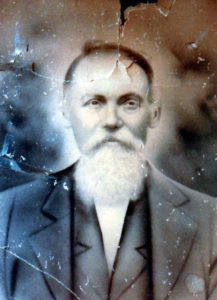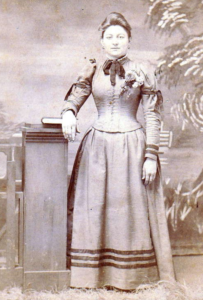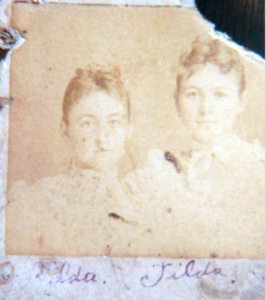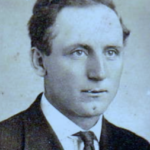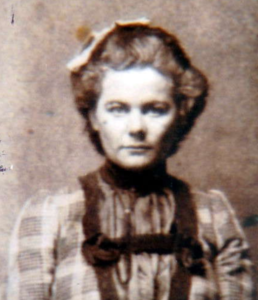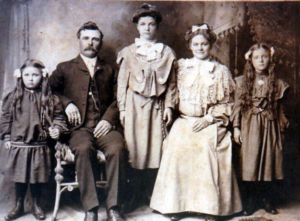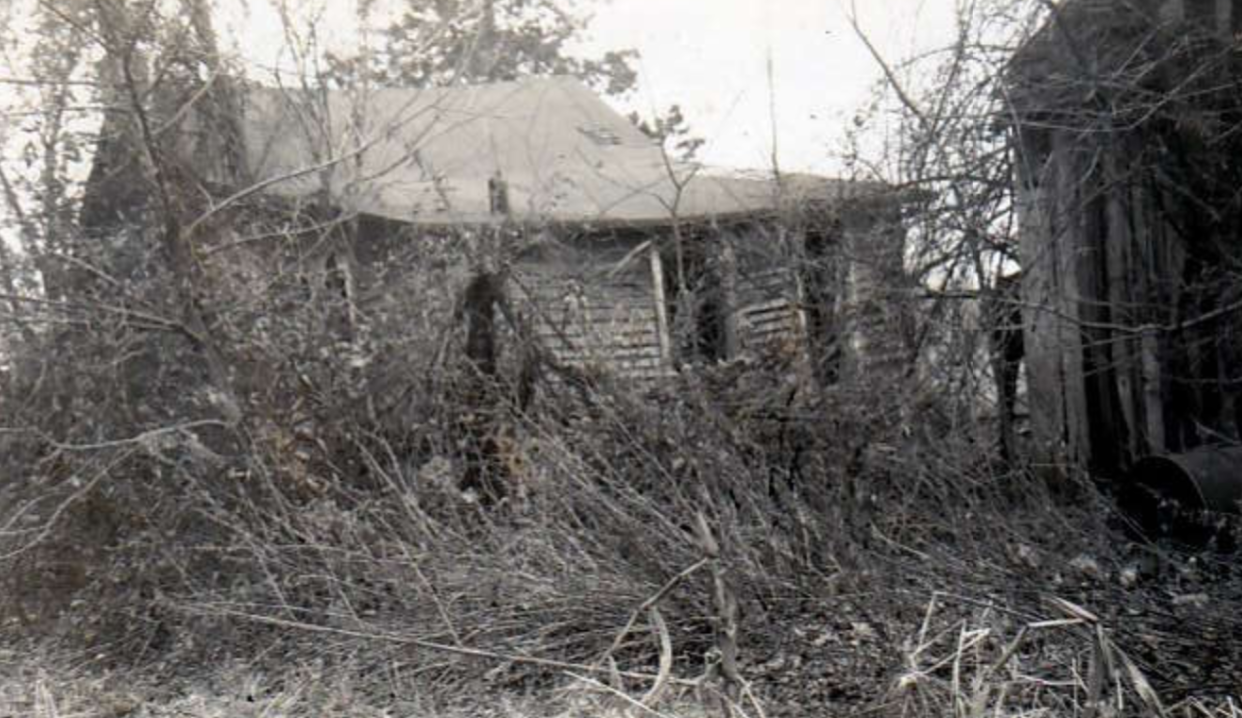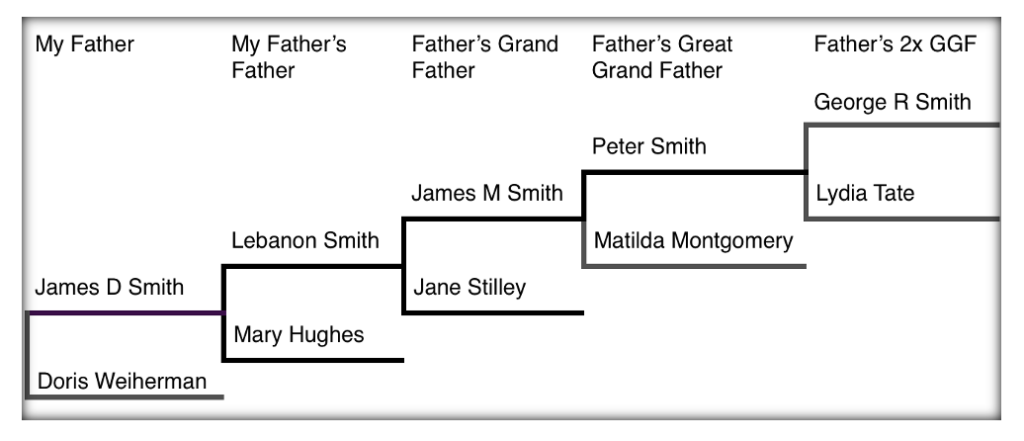Gen 4: James Monroe Smith (1846-1910) and Jane Stilley (1844-1927)
My Father’s Paternal Grandparents, Posey, IN to West Frankfort, IL
Thank you to Marilyn Haithcoat Smith for contributing the photographs that enhance this page and bring this family to life.
James Monroe Smith Jane Stilley
James Monroe Smith was the son of Peter Smith (of Posey, IN) and Matilda Montgomery. He married Jane Stilley (1844-1927) on October 15, 1866 (per the Williamson County Records). Her family first settled into southern Illinois, before there was a state of Illinois. Her dad, William Davis Stilley (1819-1890) was born in that portion of Franklin County that calved into Williamson County in 1839. Jane and James Monroe Smith lived a large part of their life together in or near West Frankfort Illinois. Links to Stille(y) ancestry are located in the Table of Contents for My Father’ Tree.
The James Monroe Smith Homestead
James and Jane had the following nine children, including Gracie who did not live to see her first birthday.
1. Peter L. Smith (1868-1886)
James and Jane’s oldest son, Peter L, was buried in the Smith family cemetery. Peter’s stone reads ‘8yrs 1mo 2days.’
2. Nancy Lucinda Smith (1870-1930)
Nancy Lucinda Smith married Holt Elmino Haithcoat (1856-1904)
Issue: Margaret Jane (1894-1900), Lillian Tennessee (1898-1955), Georgia Ann (1900-1900), Bedford Franklin (1901-1971), James Newman (1903-1976), Holt Elmino (1905-1905), Haskell Shofner (1907-1937), Bradford Haithcoat (1909-1997)
3. and 4. Marilda Harriet and Matilda Jane Smith
3. Matilda Jane Smith (1872-1954) married Amos Theodore Chapman. Matilda is to the right in this photograph.
Issue: John Ralph (1895-1955), Maud (1897-1989), Susan Jane (1899-1952), Charles Monroe (1903-1931) and Smith Chapman (1909-1976)
4. Marilda Harriet Smith (1874-1943) married [1.] John B. Vaughn (1860-1941)
Marilda is to the left in the photograph.
Issue: Sarah Ethel (1900-1942), Edward Bell (1902-1902), Matilda Elizabeth (1905-1975)
Marilda also married [2.] Frederick Roberts, issue: Frederick John
5. William Davis Smith (1877-1940) married Artenia Hol (1891-1963)
Issue: Henry Toralf (1919-1963)
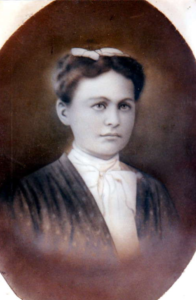 6. Martha Ann Smith (1879-1958) married William Asbury Launius (1850-1935)
6. Martha Ann Smith (1879-1958) married William Asbury Launius (1850-1935)
Issue: Louis Albert (1906-1997), Albert L. (1907-), Dallas Butler (1909-), William Wilson (1913-1977)
7. Margaret Lois Smith (1882-1968) married (1905) James Alfred Gadberry (1869-1934)
Issue: Alfred Lebanon (1906-), Davis Limuel (1910-1972), Marion Leland (1912-1979), James Leslie (1914-), Margaret Lory (1917-), Martha Jane (1919-1995)
The Gadberry family appears to be a blended family. The 1910 Census of Ramsey County North Dakota, reveals daughters Wara (age 16) and Mildred (age 11).
Margaret and James were married in 1905. Further evidence reveals that the mother of Wara and Mildred was born in Kentucky. Margaret was born in Illinois. James apparently had been married once before.
Further research: The 1900 Census for Unity, Piatt, Illlinois, identifies a ‘Jenny’ (age 26) as the wife of James Gadberry (age 31). They were married for two years and had three children: Wava (age 6), Gaynell (age 4) and Mildred (5 months). Jenny is identified as Elizabeth Jane Huglett (1874-1904).
 8. Lebanon Ferris Smith (1883-1972) married Mary Hughes (1885-1979)
8. Lebanon Ferris Smith (1883-1972) married Mary Hughes (1885-1979)
Issue: Marjorie (1911-2009), Robert Raphael (1915- ), William Stephen (1917-1994), James Donald (1922-2003)
9. Gracie Smith (1886-1886)
A Second View of the JM Smith Homestead
James Monroe and Jane (Stilley) Smith lived on land which had several underground springs. The property is platted as St Leland Springs. They wanted to open a resort boasting springs with medicinal properties, but lacked the funds for their venture and weren’t able to accomplish the goals of their business plan.
My father, James D Smith, who was born in 1922, the son of Lebanon Smith, recalled growing up with Jane Stilley Smith in the home. She was divorced from James. Family stories relate that she was a bit of a contrarian, tough to get along with and the contributed to the strife between James and Jane. The divorce was bitter and Jane was so angry that she threw away his pictures and she tore him out of every family picture in which he could be found. James then married Mary (Turner) Pritchard. Records indicate that a child, Mary (or Maude) lived in the Smith household. It is unclear as to whether the child was the offspring of James or Mr. Pritchard (Mary Turner Pritchard’s first husband).
The Smith cemetery is located in a grove of trees in a cow pasture and was in dire need of repair. Several years ago a young man earning Eagle Scout status cleaned the cemetery as part of his community project. The young man, descends from Gilbert Lafayette Smith, the brother of James Monroe Smith. The young scout and his father cleaned the cemetery and put a small fence around it. This information was provided by Dow Smith and his wife Marilyn Haithcoat Smith, who are fourth cousins and descended from Peter Smith.
LEAVING HOME
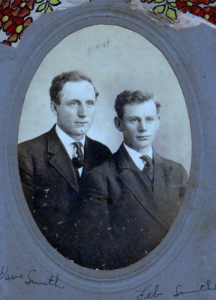 Leb (to the right) and his brother Davis (left) escaped the circle of death that trapped and killed numerous men in the southern mining community. He was 15 years old when the Coal Wars erupted, and violence spread through the neighboring communities of Cambria and Carterville in 1898. The bloody war zone was no more than 10 miles from the front doorstep of the Smith home. The violence that erupted between striking union miners and strikebreakers, considered ‘scabs’ by the miners was exacerbated by the fact that the 300 strikebreakers were black men. The breakers were brought in from Alabama by the Overholt brothers, owners of several mines. The owners recruited the breakers without telling them about the strike or the situation into which they were walking. They were innocent victims, but they were not defenseless human beings. They had families to feed and struggled for a subsistence living. When battle lines were drawn there was hell to pay and the bloodshed was equally distributed among all concerned. The court system ignored any harm done to a black man or woman. Any white brought to trial was exonerated, charges were dropped. Strikebreakers were despised regardless of color in a jury of one’s peers. Blacks were hard pressed to find any one of similar color on a panel of jurors. “Guilty!” was an inevitable outcome when black strikebreakers were charged and brought to trial. They paid dearly for any harm they had done to a white person. “Innocent!” was usually the verdict if whites harmed blacks.
Leb (to the right) and his brother Davis (left) escaped the circle of death that trapped and killed numerous men in the southern mining community. He was 15 years old when the Coal Wars erupted, and violence spread through the neighboring communities of Cambria and Carterville in 1898. The bloody war zone was no more than 10 miles from the front doorstep of the Smith home. The violence that erupted between striking union miners and strikebreakers, considered ‘scabs’ by the miners was exacerbated by the fact that the 300 strikebreakers were black men. The breakers were brought in from Alabama by the Overholt brothers, owners of several mines. The owners recruited the breakers without telling them about the strike or the situation into which they were walking. They were innocent victims, but they were not defenseless human beings. They had families to feed and struggled for a subsistence living. When battle lines were drawn there was hell to pay and the bloodshed was equally distributed among all concerned. The court system ignored any harm done to a black man or woman. Any white brought to trial was exonerated, charges were dropped. Strikebreakers were despised regardless of color in a jury of one’s peers. Blacks were hard pressed to find any one of similar color on a panel of jurors. “Guilty!” was an inevitable outcome when black strikebreakers were charged and brought to trial. They paid dearly for any harm they had done to a white person. “Innocent!” was usually the verdict if whites harmed blacks.
Life in the mines was no life at all. In fact, it was unlikely that a man who entered the mines for a living would live to tell about it. Grampa Leb was fortunate to have fled from Franklin County when he did. Living among the Grizzlies and bitter cold of the Montana mountains was a tad bit safer than staying at home with James Monroe Smith and Jane in Franklin County. Several of our Smith, Davis and Stilley relations lost their lives in periodic explosions that rocked some of the deepest coal mines in America in the first decade of the 20th Century. Many of the deaths were unnecessary and due to owner negligence, greed and disregard for the health of the miner.
There were more than 80 mines operating in southern and central Illinois feeding bituminous coal into the bellies of the industrial furnaces and locomotives of the rapidly developing railway and American economy. In the Smith’s homeland of Franklin County alone there were eight separate disasters that resulted in multiple deaths from 1905 to 1909. The data below can be found online and represents only those disasters in Franklin County. There are numerous other coal mine tragedies in Illinois alone.
Franklin County Mining Tragedies 1905-1909
April 3, 1905 Ziegler Mine ripped by an explosion and fire 48 killed
September 7, 1907 Dering Mine #11 ripped by gas explosion and fire 4 killed
November 5, 1908 Rend City Mine explosion and fire 4 killed
November 18,1908 Benton Mine explosion and fire 3 killed
December 12, 1908 Rend City Mine explosion and fire 3 killed
January 10, 1909 Ziegler Mine explosion and fire 26 killed
February 9, 1909 Ziegler Mine explosion and fire. 4 killed
February 16, 1909 Dering Mine explosion and fire: 4 killed
The number of senseless deaths is appalling. The excruciating manner in which these men died is horrifying. I was sickened by the reports that were filed in the aftermath of each tragedy. In one explosion alone, five members of a Smith family perished as did several of the Davis clan. Time and time again the government official responsible for oversight and for investigating the causes of each tragedy seemed powerless to do anything other than offer a written report and prayers for the family. Capitalist owners were cutting corners, ignoring regulations, putting men in harm’s way for profit. To make my point: in the aftermath of the January 10 explosion, the owners of the Ziegler mine were ordered to close their mine and seal off the tunnels until such time as the fires had been starved of oxygen and thus, extinguished. Each time such an order was given the owner ignored the instruction and reopened a mine prematurely. In the case of the Ziegler mine you can see the results. The embers were still burning in February 9, 1909, when the owners gave the order to open the mine. The fire still burned in the far reaches of the shaft. The mine opened, oxygen rushed in and Boom! Four men were dead.
The great labor union organizer John L. Lewis once described the “coal mine industry as the morticians’ paradise.” To put a face on the tragedies I will add this anecdotal story titled Christmas ended that night …,authored by Jim Muir in the Franklin County News (2012). Muir focuses on the devastation experienced by a Smith cousin, Geneva Smith.
“On Friday, Dec. 21, 1951, at 7:35 p.m. a violent explosion ripped through Orient 2 Mine, in West Frankfort, claiming the lives of 119 coal miners. The tragedy occurred on the last shift prior to a scheduled Christmas shutdown. News of the tragedy spread quickly from town to town and hundreds of people converged on the mine to check on loved ones and friends.”
“Nearly every person in Franklin County was affected, either directly or indirectly, by the disaster. For some of those who lost loved ones in the Orient 2 explosion, the events of that Christmas are just as vivid now as they were in 1951.”
“Perhaps no story was more poignant than that of Geneva (Hines) Smith, the 26-year-old mother of two small children, who lost her husband, Robert “Rink” Hines in the explosion. Smith, who later remarried, still brushes away a tear when she recalls the last words of her young husband before he left for work on that fateful Friday afternoon.”
“He held our daughter Joann, she was 3 months old, and he put his face against hers and he said, ‘She looks just like me … doesn’t she?” Smith recalled. “Only a few hours later his sister came to the door and said there had been an explosion … and then we learned later that he’d been killed. The last thing I remember was how happy he was holding his daughter.”
“Smith said a cruel irony involving the funeral also played out after her husband’s death.
“There was so many funerals that they had them early in the morning and all day until in the evening,” Smith remembered. “The only time we could have his funeral was at 8 p.m. on Christmas Eve. That was our fifth wedding anniversary and we got married at 8 p.m. … I’ll never forget that.”
Woody Guthrie was able to capture the desolation and loss of life in the epic lyrics of his song, The Dying Miner. As he penned the song, Guthrie held in his hands the notes that dying miners had scrawled to their loved ones as they took their last breath of contaminated air, choking on the smoke of the burning coal and the fumes of the methane gas burn off.
“It happened an hour ago way down in this tunnel of coal. Gas caught fire from somebody’s lamp and the miners are choking in smoke. Goodbye to Dickie and Honey. Goodbye to the wife I love….”
The song goes on, tugging at the heartstrings. One refrain that is found in so many of the notes scratched out by dying men held out the hope that the catastrophe would capture the attention of the government and force the regulation of the mining industry. It was a plea that had been ignored earlier in the 20th Century. Today, in 2017 we have a President who has asked his cabinet to rid the corporate world of any regulations that bind owner’s hands and reduce their profits. The death of Rink Hines, the words of Woody Guthrie, the mining disaster mean nothing to the Donald Trumps of the world.
Lebanon Faris Smith and brother Davis were able to avoid the life of the coal miner and pursued their dreams and adventures in the new frontier of the American West. It may have cost grampa a few fingers, but it did not cost him his life. The experience of the James Monroe Smith family in Southern Illinois was not our family’s first close call with the mining industry. We were also victims of the disastrous impact that Mr. Peabody’s mine had on south-central Kentucky. It was a piece of family history that was hidden from my father’s world view. We will soon find ourselves in Paradise, if you want to call it that, with a more contemporary singer/songwriter.
In Summation
Let’s stop this speeding train wreck on its’ tracks for a moment and gather together all that I have thrown at you. We can fill in the blanks after I grab a coffee and continue with the history in a moment. Right now, I need caffeine.
I am your tour guide, Steve Smith, (b 1949) and I have three sisters (April, Chris and Shelley) each of whom claims these same ancestors! Our father was James Donald Smith (1922-2003). Our mother was Doris Christine Weiherman (1923-1978). Our grandfather was Lebanon Faris Smith (1883-1972) and his father was James Monroe Smith (1846-1910). We will come back to the women of this tree. They are not forgotten. James Monroe Smith had a father, Peter Smith (1803-1870) and I will call him Peter Smith of Posey. We are going to meet so many Peters before this trek is over that you are going to think you are in a sausage factory.
The migration pattern established in the previous centuries took James Monroe Smith from his childhood home in Posey Township, Indiana to his resting place in Franklin County, Illinois. His sons, Davis and Lebanon toured the Northwest and settled in North Dakota. Lebanon then married Mary Hughes and they made their home, first in Wisconsin and then Minnesota. Leb passed away in Auburn, Alabama, and was buried in the Hughes plot in Springfield, SD. My father was born in Wisconsin, raised in Minnesota and attended college at Northern Illinois University, DeKalb, Illinois before spending his teaching career in West Chicago, Illinois. My sisters were April, Christine and Shelley. We spent our childhood in that suburb of Chicago. Our idea of a good time was a Tastee Freeze ice cream cone or a Dog n Suds root beer float.We were two generations removed from the tragedies that beset Williamson County IL.
Pedigree Chart 4 shows JD and Doris Smith to the left and grandparents Leb and Mary Smith. The three generations of Smith lineage that preceded Lebanon are also revealed. George Rudolphus Smith (1772-1840) was born at Round Hill Plantation (Caswell County NC). George and Lydia Jenny Tate left the plantation life behind in Carolina and began the migration north, first to Kentucky and then Indiana. Peter Smith and Matilda lived in Posey, Indiana. James Monroe Smith moved with Jane Stilley to southern Illinois. It was in West Frankfort IL that my Grampa Leb Smith was born in 1883.
Pedigree Chart 4: Five Generations of Smiths
Dad’s history lessons never predated 1800 and always concluded with a variation on a sentence like this:
“No one really knows from where and when my father’s great grandfather Peter Smith came to America. Some believed he was a Colonel in the British army who helped Wellington defeat Napoleon at Waterloo before coming to America.”
A FOOTNOTE IN HISTORY
The Herrin Massacre: took place in 1922 in Herrin, Illinois during a nationwide strike by the United Mineworkers of America. The owner of the mine violated an agreement with the union and fired his entire workforce. He hired strikebreakers and continued operations. Enraged union miners fired on the streakbreakers and laid siege to the mine. The owner hired guards armed with gatling guns and returned the fire. Three union men were killed. The following day the union men killed the mine superintendent McDowell and 18 of his 50 strikebreakers. The 50 men and McDowell had been deceived by the union, led to believe that if they surrendered they would be given safe passage from the county. Instead they were forced marched from the mine to Herrin, a five-mile journey they never completed. Within a half mile they were lined up along a fence and miners opened fire on them. The miners yelled, “Run for your lives,” and the strikebreakers did, fleeing as best they could across the fields and forest. It was target practice time for the union men. McDowell was found bound and shot four times. Several bodies were dumped in front of Smith’s Garage in Herrin. Which cousin Smith we do not know. Our namesakes, Leb and Davis were long gone and raising families in the Northwoods and Great Plains.

